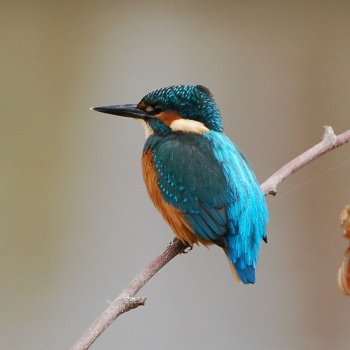Overview
Venus Pool is an old gravel pit situated outside Cross Houses near Shrewsbury in Shropshire, owned by the Shropshire Ornithological Society.
In spring/early summer Lesser Whitethroat, Garden Warbler and Sedge Warbler can be seen in the hedges near the car park. Kingfisher are often perched in front of the main hide in the summer giving excellent photo opportunities.
In the autumn the hedgerows and top field attract very large flocks of finches and buntings. This field is planted with a wild bird seed mixture including Quinoa, Chicory, Fat Hen and a strip of cereals. Hundreds of European Goldfinch can be seen along with Eurasian Tree Sparrow. Common Redstart, Whinchat and Spotted Flycatcher can sometimes be seen in late summer.
At the feeding station Eurasian Tree Sparrow, Marsh Tit, Great Spotted Woodpecker, Sparrowhawk, Wood Nuthatch and all the common tits and finches can be easily seen, usually several Brambling in the winter too.
The pool usually attracts various waders, terns and an Osprey on passage especially in the autumn. The hide on the far side of the pool can give good views of Bittern, Water Rail and Eurasian Siskin in the winter.
Birds
Notable Species
To do
Rarities
Previous rarities include: Red-throated Diver, Ring-necked Duck, Spotted Crake, Grey Phalarope, Purple Heron, Short-eared Owl, Long-eared Owl, Eurasian Spoonbill, Black-winged Stilt, Gull-billed Tern, Tundra Swan, Velvet Scoter, Smew, and Red Knot.
Check-list
Birds you can see here include:
Little Grebe, Great Crested Grebe, Black-necked Grebe, Great Cormorant, Little Egret, Grey Heron, Eurasian Spoonbill, Mute Swan, Pink-footed Goose, Greylag Goose, Canada Goose, Barnacle Goose, Common Shelduck, Mandarin Duck, Eurasian Wigeon, Gadwall, Common Teal, Mallard, Northern Pintail, Garganey, Northern Shoveler, Red-crested Pochard, Common Pochard, Tufted Duck, Greater Scaup, Common Goldeneye, Goosander, Ruddy Duck, Red Kite, Hen Harrier, Eurasian Sparrowhawk, Common Buzzard, Osprey, Common Kestrel, Merlin, Eurasian Hobby, Peregrine Falcon, Red-legged Partridge, Common Pheasant, Water Rail, Common Moorhen, Common Coot, Eurasian Oystercatcher, Little Ringed Plover, Ringed Plover, European Golden Plover, Northern Lapwing, Sanderling, Little Stint, Curlew Sandpiper, Dunlin, Ruff, Jack Snipe, Common Snipe, Eurasian Woodcock, Black-tailed Godwit, Bar-tailed Godwit, Whimbrel, Eurasian Curlew, Spotted Redshank, Common Redshank, Common Greenshank, Green Sandpiper, Wood Sandpiper, Common Sandpiper, Mediterranean Gull, Black-headed Gull, Common Gull, Lesser Black-backed Gull, European Herring Gull, Great Black-backed Gull, Common Tern, Arctic Tern, Stock Dove, Common Woodpigeon, Feral Pigeon, Common Cuckoo, Western Barn Owl , Tawny Owl, Common Swift, Common Kingfisher, Green Woodpecker, Great Spotted Woodpecker, Lesser Spotted Woodpecker, Eurasian Skylark, Sand Martin, Barn Swallow, Western House Martin, Meadow Pipit, Yellow Wagtail, Grey Wagtail, Pied Wagtail, Eurasian Wren, Hedge Accentor, European Robin, Common Redstart, Whinchat, European Stonechat, Northern Wheatear, Eurasian Blackbird, Fieldfare, Song Thrush, Redwing, Mistle Thrush, Sedge Warbler, Common Reed Warbler, Lesser Whitethroat, Common Whitethroat, Garden Warbler, Blackcap, Common Chiffchaff, Willow Warbler, Goldcrest, Spotted Flycatcher, Long-tailed Tit, Marsh Tit, Coal Tit, Great Tit, Blue Tit, Wood Nuthatch, Eurasian Treecreeper, Eurasian Jay, Common Magpie, Eurasian Jackdaw, Rook, Carrion Crow, Common Raven, Common Starling, House Sparrow, Eurasian Tree Sparrow, Chaffinch, Brambling, European Greenfinch, European Goldfinch, Eurasian Siskin, Eurasian Linnet, Lesser Redpoll, Eurasian Bullfinch, Yellowhammer, Reed Bunting
Site Information
History and Use
Originally a large pool in a field, probably formed when the railway embankment on the north side was built and impeded natural drainage. The land to the east was eventually quarried for the sand and gravel deposits and waste water was pumped from the excavations into the pool.
When the quarry closed the main workings were re-profiled to form the present day trout pool to the south-east and Venus Pool gradually returned to a more natural condition.
The site was acquired by the SOS and work commenced to improve the habitat for wildfowl and wading birds. Two brick hides were built to allow members of the SOS to watch the birds and the number of visitors began to increase. More hides have since been added.
The pool was re-profiled and car park and extra hides built. Additional land was purchased to include the fields around the pool and these are being managed to produce an area of marsh and a grassy meadow.
Areas of Interest
Pool with scrapes, reed beds, marsh, grassy meadow, butterfly path and a feeding station within an area of willow scrub.
Access and Facilities
Venus Pool is located just south of the A458 Shrewsbury to Bridgnorth road between Cross Houses and Cressage. Turn right for Pitchford after leaving Cross Houses; about 1/2 mile on left.
The gate to the car park (which has a 2m height barrier) is open all day. There are no toilets and dogs are not allowed on the reserve.
There are three hides and two more are currently under construction. From the end of Sep '09 - There will be four public hides, two overlooking the pool, one behind the reed bed on the far side of the pool and one at the feeding station. A further hide overlooks the north marsh and is for Shropshire Ornithological Society members only, however is not used much as the public ones give the best views of most of the reserve.
There is an additional small disabled parking area close to the hides, most of which have ramps to be accessible to disabled birdwatchers.
Grid Ref: SJ548062
Places to Visit Nearby
Contact Details
County Bird Recorder - Geoff Holmes
geoff.holmes.4 "at" btinternet.com
External Links
- Shropshire Ornithological Society
- Shropshire Ornithological Society: Venus Pool
- Venus Pool on Streetmap
Content and images originally posted by jacana and added to by Kezza





